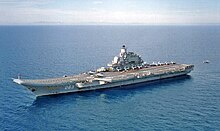West Cork oil spill
This article documents a current event. Information may change rapidly as the event progresses, and initial news reports may be unreliable. The latest updates to this article may not reflect the most current information. (February 2009) |

The West Cork oil spill is an ongoing oil spill off the southern coast of Ireland. The origin of the spill is unclear but it was first identified by satellite by the European Maritime Safety Agency on 14 February 2009 and an Irish Air Corps marine patrol aircraft first spotted the slick around the Russian Navy aircraft carrier Admiral Kuznetsov which was undergoing refuelling around the same time. The Russian Navy has denied that any spills occurred during the refuelling process. The oil spill is proceeding eastwards and is expected to wash up on the coast of Ireland and Wales within 16 days.
Discovery
On 14 February 2009, the Irish Coast Guard received a European Maritime Safety Agency satellite surveillance report indicating the presence of pollution off the south coast of Ireland.[1] The Coast Guard dispatched an Irish Air Corps CASA CN-235 maritime patrol aircraft to investigate which confirmed the presence of oil on the surface of the sea around a Russian Navy oil tanker and the Admiral Kuznetsov aircraft carrier.[1][2] The spill was located in international waters 80 km (50 mi) south of Fastnet Rock, Ireland's most southwesterly point, and spread over an area measuring 6.4 km (4 mi) by 8 km (5 mi).[3][4]

On 16 February, the Russian naval attaché in Ireland confirmed that the Admiral Chabanenko and Admiral Kuznetsov had been carrying out a fuel transfer operation and that Russian air surveillance had estimated that 300 tonnes of fuel was spilled.[1][5] The Russian Navy offered no explanation for the presence of the oil but began an internal investigation into the matter.[1] The commander of the Admiral Kuznetsov has stated that the refuelling proceeded in a routine manner and that there had been no leaks. The Russian Navy says that it is willing to share data in an attempt to identify the origin of the spill which it says is "not catastrophic in nature and does not present a threat to the coastal environment".[2][4] The Admiral Kuznetsov is normally accompanied by at least one ocean-going tug in case of breakdown.[3] The carrier was en route to its home port following exercises in the Mediterranean Sea where, on January 6, it suffered a fire which resulted in the death of one sailor.[3]
The British Coastguard initially estimated the quantity of oil spilled as around 1,000 tonnes, a figure which the Irish Department of Transport agreed with.[1][6] If this is accurate then this is the biggest oil spill to have affected Great Britain and Ireland since the Sea Empress ran aground near Milford Haven in 1996.[3]
Current situation
Late on 17 February 2009, the estimated amount of oil was revised downwards to 522 tonnes and it was 63 kilometres (39 mi) off the Irish coast.[6] The slick is moving eastwards along Ireland's south coast at around 48–64 km (30-40 mi) offshore.[1] The Irish Coast Guard has run computer simulations of the spill and expects some oil to dissolve or evaporate but the majority to remain on the surface of the sea. The Coast Guard does however maintain that weather conditions will determine the course of the slick and as such any landfall. Depending on weather conditions, the spill could wash up onto the Irish south-east coast in around 16 days and may hit Wales in two to three weeks.[3] On its current path, it will enter British territorial waters around the 22 February. If the spill washes onto shore it may affect birds, dolphins, porpoises and seals.[3] Oil washed up in Ireland will be recovered mechanically by local authorities with the assistance and supervision of the Coast Guard.[1]
Vessels currently on the scene include two Russian refuelling tankers, Admiral Kuznetsov, a Russian destroyer, the Admiral Chabanenko, a British destroyer and LÉ Aisling, an Irish Naval Service vessel. The Irish Coast Guard expects the Russian vessels to leave on 18 February, having completed refuelling.[1] Samples of the oil have been taken for analysis at the Maritime and Coastguard Agency's labs in Edinburgh, and Ireland has requested samples of oils carried on board the Russian vessels from the Russian Embassy in Dublin.[3] The Irish Coast Guard has dispatched a tug from Cork to evaluate whether at sea recovery of the oil is possible.[1]
References
- ^ a b c d e f g h i Irish Department of Transport (17 February 2009), Coastguard Press Release- Oil Spill fifty miles south of Fastnet, retrieved 2009-2-17
{{citation}}: Check date values in:|accessdate=(help) - ^ a b RIA Novosti (17 February 2009), Media exaggerating oil spill off Irish coast, retrieved 2009-2-17
{{citation}}: Check date values in:|accessdate=(help) - ^ a b c d e f g Smith, Lewis (17 February 2009), Huge oil slick from Russian ship heads for British coastline
{{citation}}: Unknown parameter|acessdate=ignored (|access-date=suggested) (help) - ^ a b Sweeney, Conor (17 February 2009), Russia denies causing oil spill off Irish coast, retrieved 2009-2-17
{{citation}}: Check date values in:|accessdate=(help) - ^ Bloomberg.com (17 February 2009), Oil Spill Off Ireland May Hit Irish, Welsh Shores (Update1), retrieved 2009-2-17
{{citation}}: Check date values in:|accessdate=(help) - ^ a b RTÉ News (17 February 2009), Oil slick may reach Wexford in 16 days, retrieved 2009-2-17
{{citation}}: Check date values in:|accessdate=(help)
